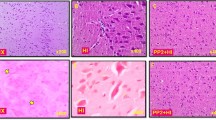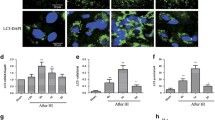Abstract
Previous studies have shown that hyperoxia results in cerebral cortical neuronal apoptosis. Studies have also shown that phosphorylation of anti-apoptotic proteins Bcl-2 and Bcl-xl results in loss of their anti-apoptotic potential leading to alteration in mitochondrial membrane permeability and the release of apoptogenic proteins in the neuronal cell of the newborn piglets. The present study tests the hypothesis that cerebral hyperoxia will result in increased serine phosphorylation of apoptotic proteins Bcl-2, Bcl-xl, Bax, and Bad in the mitochondrial membranes of the cerebral cortex of newborn piglets. Twelve newborn piglets were divided into normoxic (Nx, n = 6) exposed to an FiO2 of 0.21 for 1 h and hyperoxic (Hyx, n = 6) exposed to FiO2 of 1.0 for 1 h. In the Hyx group, PaO2 was maintained above 400 mmHg while the Nx group was kept at 80–100 mmHg. Cerebral cortical tissue was harvested and mitochondrial fractions were isolated. Mitochondrial membrane proteins were separated using 12% SDS-PAGE, and probed with anti-serine phosphorylated Bcl-2, Bcl-xl, Bax, and Bad antibodies. Protein bands were detected, analyzed by imaging densitometry and density expressed as absorbance (OD × mm2). Phosphorylated Bcl-2 (p-Bcl-2) protein density (OD × mm2) was 81.81 ± 9.24 in Nx and 158.34 ± 10.66 in Hyx (P < 0.05). Phosphorylated Bcl-xl (p-Bcl-xl) protein density was 52.98 ± 3.59 in Nx and 99.62 ± 18.22 in Hyx (P < 0.05). Phosphorylated Bax (p-Bax) protein was 161.13 ± 6.27 in Nx and 174.21 ± 15.95 in Hyx (P = NS). Phosphorylated Bad (p-Bad) protein was 166.24 ± 9.47 in Nx 155.38 ± 12.32 in Hyx (P = NS). The data show that there is a significant increase in serine phosphorylation of Bcl-2 and Bcl-xl proteins while phosphorylation of Bad and Bax proteins were not altered during hyperoxia in the mitochondrial fraction of the cerebral cortex of newborn piglets. We conclude that hyperoxia results in differential post-translational modification of anti-apoptotic proteins Bcl-2 and Bcl-xl as compared to pro-apoptotic proteins Bax and Bad in mitochondria. We speculate that phosphorylation of Bcl-2 and Bcl-xl will result in loss of their anti-apoptotic potential by preventing their dimerization with Bax leading to activation of the caspase cascade of neuronal death.



Similar content being viewed by others
References
Banasiak KJ, Xia Y, Haddad GG (2000) Mechanisms underlying hypoxia-induced neuronal apoptosis. Prog Neurobiol 62:215–249. doi:10.1016/S0301-0082(00)00011-3
Hu X, Qiu J, Grafe MR et al (2003) Bcl-2 family members make different contributions to cell death in hypoxia and/or hyperoxia in rat cerebral cortex. Int J Dev Neurosci 21:371–377. doi:10.1016/S0736-5748(03)00089-3
Felderhoff-Mueser U, Bittigau P, Sifringer M et al (2004) Oxygen causes cell death in the developing brain. Neurobiol Dis 17:273–282. doi:10.1016/j.nbd.2004.07.019
Sirinyan M, Sennlaub F, Dorfman A et al (2006) Hyperoxic exposure leads to nitrative stress and ensuing microvascular degeneration and diminished brain mass and function in the immature subject. Stroke 37:2807–2815. doi:10.1161/01.STR.0000245082.19294.ff
Taglialatela G, Perez-Polo JR, Rassin DK (1998) Induction of apoptosis in the CNS during development by the combination of hyperoxia and inhibition of glutathione synthesis. Free Radic Biol Med 25:936–942. doi:10.1016/S0891-5849(98)00131-2
Gill MB, Bockhorst K, Narayana P et al (2008) Bax shuttling after neonatal hypoxia-ischemia: hyperoxia effects. J Neurosci Res 86:3584–3604. doi:10.1002/jnr.21795
Ashraf QM, Zanelli SA, Mishra OP et al (2001) Phosphorylation of Bcl-2 and Bax proteins during hypoxia in newborn piglet. Neurochem Res 26:1–9. doi:10.1023/A:1007654912421
Dean JB, Mulkey DK, Garcia AJ 3rd et al (2003) Neuronal sensitivity to hyperoxia, hypercapnia, and inert gases at hyperbaric pressures. J Appl Physiol 95:883–909
Dean JB, Mulkey DK, Henderson RAIII et al (2004) Hyperoxia, reactive oxygen species, and hyperventilation: oxygen sensitivity of brain stem neurons. J Appl Physiol 96:784–791. doi:10.1152/japplphysiol.00892.2003
Mulkey DK, Henderson RAIII, Olson JE et al (2001) Oxygen measurements in brain stem slices exposed to normobaric hyperoxia and hyperbaric oxygen. J Appl Physiol 90:1887–1899. doi:10.1063/1.1383259
Chang E, Hornick K, Fritz KI et al (2007) Effect of hyperoxia on cortical neuronal nuclear function and programmed cell death mechanisms. Neurochem Res 32:1142–1149. doi:10.1007/s11064-007-9282-4
Clement MV, Pervaiz S (1999) Reactive oxygen intermediates regulate cellular response to apoptotic stimuli: an hypothesis. Free Radic Res 30:247–252. doi:10.1080/10715769900300271
Saugstad OD (1996) Mechanisms of tissue injury by oxygen radicals: implications for neonatal disease. Acta Paediatr 85:1–4. doi:10.1111/j.1651-2227.1996.tb13880.x
Budinger GR, Tso M, McClintock DS et al (2002) Hyperoxia-induced apoptosis does not require mitochondrial reactive oxygen species and is regulated by Bcl-2 proteins. J Biol Chem 277:15654–15660. doi:10.1074/jbc.M109317200
Freeman BA, Crapo JD (1981) Hyperoxia increases oxygen radical production in rat lungs and lung mitochondria. J Biol Chem 256:10986–10992
Droge W (2002) Free radicals in the physiological control of cell function. Physiol Rev 82:47–95
Thom SR, Bhopale V, Fisher D et al (2002) Stimulation of nitric oxide synthase in cerebral cortex due to elevated partial pressures of oxygen: an oxidative stress response. J Neurobiol 51:85–100. doi:10.1002/neu.10044
Hoehn T, Felderhoff-Mueser U, Maschewski K et al (2003) Hyperoxia causes inducible nitric oxide synthase-mediated cellular damage to the immature rat brain. Pediatr Res 54:179–184. doi:10.1203/01.PDR.0000075220.17631.F1
Blagosklonny MV, Giannakakou P, el-Deiry WS et al (1997) Raf-1/bcl-2 phosphorylation: a step from microtubule damage to cell death. Cancer Res 57:130–135
Delivoria-Papadopoulos M, Mishra OP (2000) Mechanisms of perinatal cerebral injury in fetus and newborn. Ann N Y Acad Sci 900:159–168
Saugstad OD (2001) Is oxygen more toxic than currently believed? Pediatrics 108:1203–1205. doi:10.1542/peds.108.5.1203
Vexler ZS, Ferriero DM (2001) Molecular and biochemical mechanisms of perinatal brain injury. Semin Neonatol 6:99–108. doi:10.1053/siny.2001.0041
Oltvai ZN, Milliman CL, Korsmeyer SJ (1993) Bcl-2 heterodimerizes in vivo with a conserved homolog, Bax, that accelerates programmed cell death. Cell 74:609–619. doi:10.1016/0092-8674(93)90509-O
Ito T, Deng X, Carr B et al (1997) Bcl-2 phosphorylation required for anti-apoptosis function. J Biol Chem 272:11671–11673. doi:10.1074/jbc.272.18.11671
Haldar S, Chintapalli J, Croce CM (1996) Taxol induces Bcl-2 phosphorylation and death of prostate cancer cells. Cancer Res 56:1253–1255
Haldar S, Jena N, Croce CM (1995) Inactivation of Bcl-2 by phosphorylation. Proc Natl Acad Sci USA 92:4507–4511. doi:10.1073/pnas.92.10.4507
Lamprecht WSP, Heinz F, Weissner H (1974) Creatine phosphate. In: Bergmeyer HU (ed) Methods of enzymatic analysis, vol 4. Academic Press, New York, pp 1777–1781
Booth RF, Clark JB (1978) A rapid method for the preparation of relatively pure metabolically competent synaptosomes from rat brain. Biochem J 176:365–370
Lowry OH, Rosebrough NJ, Farr AL et al (1951) Protein measurement with the folin phenol reagent. J Biol Chem 193:265–275
Barazzone C, White CW (2000) Mechanisms of cell injury and death in hyperoxia: role of cytokines and Bcl-2 family proteins. Am J Respir Cell Mol Biol 22:517–519
Chandel NS, Budinger GR (2007) The cellular basis for diverse responses to oxygen. Free Radic Biol Med 42:165–174. doi:10.1016/j.freeradbiomed.2006.10.048
Metrailler-Ruchonnet I, Pagano A, Carnesecchi S et al (2007) Bcl-2 protects against hyperoxia-induced apoptosis through inhibition of the mitochondria-dependent pathway. Free Radic Biol Med 42:1062–1074. doi:10.1016/j.freeradbiomed.2007.01.008
Hu ZB, Minden MD, McCulloch EA (1998) Phosphorylation of BCL-2 after exposure of human leukemic cells to retinoic acid. Blood 92:1768–1775
Ruvolo PP, Deng X, Carr BK et al (1998) A functional role for mitochondrial protein kinase Calpha in Bcl2 phosphorylation and suppression of apoptosis. J Biol Chem 273:25436–25442. doi:10.1074/jbc.273.39.25436
Shitashige M, Toi M, Yano T et al (2001) Dissociation of Bax from a Bcl-2/Bax heterodimer triggered by phosphorylation of serine 70 of Bcl-2. J Biochem 130:741–748
Yamamoto K, Ichijo H, Korsmeyer SJ (1999) BCL-2 is phosphorylated and inactivated by an ASK1/Jun N-terminal protein kinase pathway normally activated at G(2)/M. Mol Cell Biol 19:8469–8478
Zha J, Harada H, Yang E et al (1996) Serine phosphorylation of death agonist BAD in response to survival factor results in binding to 14–3-3 not Bcl-X(L). Cell 87:619–628. doi:10.1016/S0092-8674(00)81382-3
Chang BS, Minn AJ, Muchmore SW et al (1997) Identification of a novel regulatory domain in BCL-X(L) and Bcl-2. EMBO J 16:968–977. doi:10.1093/emboj/16.5.968
Truttmann AC, Ashraf Q, Mishra OP et al (2004) Effect of hypoxia on protein phosphatase 2A activity, subcellular distribution and expression in cerebral cortex of newborn piglets. Neuroscience 127:355–363. doi:10.1016/j.neuroscience.2004.05.033
Vander Heiden MG, Chandel NS, Schumacker PT et al (1999) Bcl-xL prevents cell death following growth factor withdrawal by facilitating mitochondrial ATP/ADP exchange. Mol Cell 3:159–167. doi:10.1016/S1097-2765(00)80307-X
Kluck RM, Bossy-Wetzel E, Green DR et al (1997) The release of cytochrome c from mitochondria: a primary site for Bcl-2 regulation of apoptosis. Science 275:1132–1136. doi:10.1126/science.275.5303.1132
Olson M, Kornbluth S (2001) Mitochondria in apoptosis and human disease. Curr Mol Med 1:91–122. doi:10.2174/1566524013364239
Desagher S, Osen-Sand A, Nichols A et al (1999) Bid-induced conformational change of Bax is responsible for mitochondrial cytochrome c release during apoptosis. J Cell Biol 144:891–901. doi:10.1083/jcb.144.5.891
Mikhailov V, Mikhailova M, Pulkrabek DJ (2001) Bcl-2 prevents Bax oligomerization in the mitochondrial outer membrane. J Biol Chem 276:18361–18374. doi:10.1074/jbc.M100655200
Hsu YT, Wolter KG, Youle RJ (1997) Cytosol-to-membrane redistribution of Bax and Bcl-X(L) during apoptosis. Proc Natl Acad Sci USA 94:3668–3672. doi:10.1073/pnas.94.8.3668
Smaili SS, Hsu YT, Carvalho AC et al (2003) Mitochondria, calcium and pro-apoptotic proteins as mediators in cell death signaling. Braz J Med Biol Res 36:183–190
Jurgensmeier JM, Xie Z, Deveraux Q et al (1998) Bax directly induces release of cytochrome c from isolated mitochondria. Proc Natl Acad Sci USA 95:4997–5002. doi:10.1073/pnas.95.9.4997
Luo X, Budihardjo I, Zou H et al (1998) Bid, a Bcl2 interacting protein, mediates cytochrome c release from mitochondria in response to activation of cell surface death receptors. Cell 94:481–490. doi:10.1016/S0092-8674(00)81589-5
Acknowledgments
This study was supported by the National Institutes of Health grant HD-20337 and by iNO therapeutics. The authors express their gratitude to Ms. Anli Zhu for her expert technical assistance.
Author information
Authors and Affiliations
Corresponding author
Rights and permissions
About this article
Cite this article
Brutus, N.A., Hanley, S., Ashraf, Q.M. et al. Effect of Hyperoxia on Serine Phosphorylation of Apoptotic Proteins in Mitochondrial Membranes of the Cerebral Cortex of Newborn Piglets. Neurochem Res 34, 1219–1225 (2009). https://doi.org/10.1007/s11064-008-9898-z
Accepted:
Published:
Issue Date:
DOI: https://doi.org/10.1007/s11064-008-9898-z




